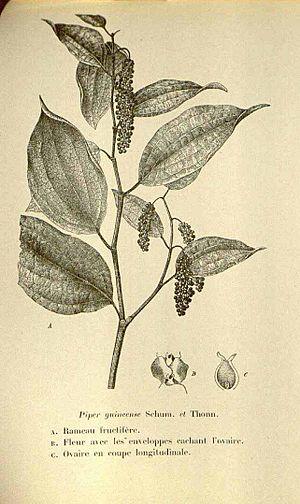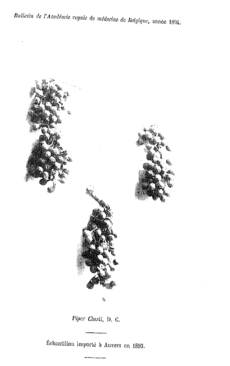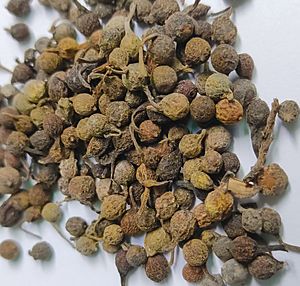Piper guineense facts for kids
Quick facts for kids Piper guineense |
|
|---|---|
 |
|
| Scientific classification | |
| Genus: |
Piper
|
| Species: |
guineense
|
| Synonyms | |
|
Piper clusii C.DC. |
|
Piper guineense is a plant that grows in West Africa. The spice that comes from its dried fruit is known by many names, like Ashanti pepper, Benin pepper, Edo pepper, false cubeb, and Guinea cubeb. Locally, people call it kale, kukauabe, masoro, etiñkeni, sasema, soro wisa, eyendo, eshasha (by the Urhobo people), oziza, and uziza.
This plant is a close relative of cubeb pepper and also related to black pepper and long pepper. Unlike cubeb pepper, which is round, Ashanti pepper grains are shaped like an oval. They are smaller and smoother than cubeb pepper and often have a reddish color. The stems of Ashanti pepper berries are also curved, while cubeb pepper stems are straight. Sometimes, the names West African pepper and Guinea pepper are used, but these can also mean other spices like grains of Selim or grains of paradise.
The plants that give us Ashanti pepper are vines. They can grow up to 20 meters (about 65 feet) long, climbing up tree trunks using special roots. These plants grow naturally in warm, wet parts of Central and Western Africa. People also grow them in countries like Nigeria. There, the leaves, called uziza, are used to flavor stews. Like other plants in the pepper family, Ashanti pepper contains a chemical called piperine. This is what gives them their spicy taste. They also have other important natural chemicals like beta-caryophyllene, which scientists are studying for its ability to reduce swelling.
Ashanti pepper tastes very similar to cubeb pepper. However, it is less bitter and has a fresher, more herbal flavor and smell. Cubeb pepper often smells more like pine. Ashanti pepper was known in Europe during the Middle Ages. It was a common spice in cities like Rouen and Dieppe in 14th-century France. But today, it is mostly used in West and Central Africa.
Using Ashanti Pepper in Cooking
Ashanti pepper is a key ingredient in West African cooking. It adds a spicy and strong smell to stews. Even in West Africa, Ashanti pepper is an expensive spice, so people use it carefully. Often, a few grains are crushed in a mortar and pestle. Then, they are added to soups or boiled rice, sometimes with black pepper.
You can also use Ashanti pepper in any recipe that asks for cubeb pepper. When you do, Ashanti pepper will give a less bitter taste. This pepper is also sometimes part of the Berbere spice mix. This mix is used in the foods of Ethiopia and Eritrea. However, because West African Pepper can be hard to find outside its home region, long pepper is more often used in Berbere.
Ashanti Pepper as a Preservative
Studies show that Ashanti peppers can help keep food fresh and prevent it from spoiling. They also have properties that fight against damage to cells. In one study, scientists compared three types of West African peppers. They looked at how well each pepper preserved catfish. The study found that Ashanti peppers were the most effective at keeping the fish fresh.
See also
 In Spanish: Pimienta de Guinea para niños
In Spanish: Pimienta de Guinea para niños



